Research Projects
Our stakeholder-oriented research program focuses on developing applicable and successful disease management strategies. We aim to develop both short-term tactics to reduce disease severity and mitigate yield losses, as well as mid- and long-term tactics that aim to change production conditions in order to reduce disease pressure and facilitate sustainable and economic crop production in Montana.
This page contains the latest Extension Field Crop Pathology research projects. For further details about a specific project, contact EXtension Plant Pathologist Uta McKelvy.
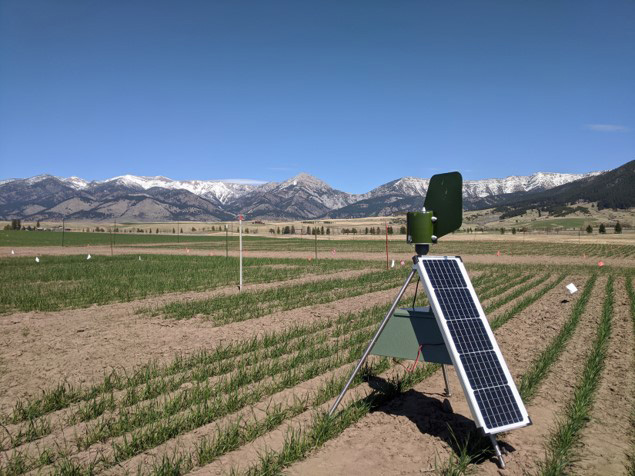
We use solar-powered cyclone spore samplers to capture airborne pathogen spores in winter wheat fields. Larger image (112 KB).
National Predictive Modeling Tool Initiative for Wheat in Montana
Collaborators: Uta McKelvy, Linda Hebb.
This project increases our understanding of the role of presence and abundance of pathogen inoculum, host susceptibility, and weather conditions in foliar disease risk. The focus is on winter wheat. Our research data will be used to develop and improve predictive models for foliar diseases of wheat, which will support growers in making effective and economic disease management decisions. Project work started in September 2020. We are conducting field experiments at MSU research farms and observation studies in grower fields.
The National Predictive Modeling Tool Initiative is a multi-state, multi-year collaborative project that focuses on wheat and other crops of economic importance to U.S. agriculture.
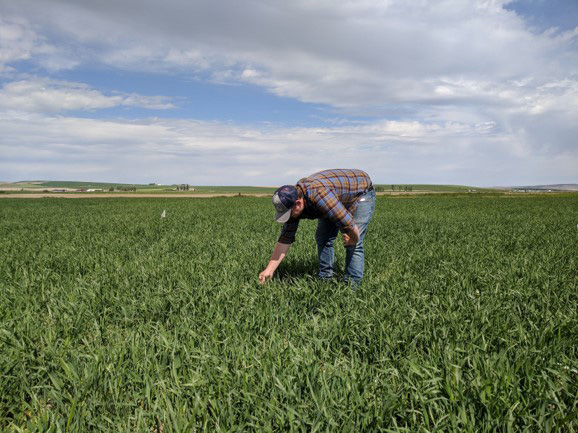
Graduate Student Everet Owen is assessing incidence and severity of leaf spot diseases in a spring wheat field.
Assessing Pathogen Inoculum Density and Foliar and Head Disease Development in Dryland and Irrigated Spring Wheat Fields
Collaborators: Uta McKelvy, Mary Burrows (MSU). Graduate student: Karl Everet Owen.
This project assesses pathogen presence and abundance, onset, and development of foliar and rust diseases, and head scab in irrigated compared to dryland spring wheat fields. We will gather information on disease pressure in local production systems and use it to develop management recommendations specific to Montana spring wheat production conditions. The project compliments and expands the objectives of our National Predictive Modeling Tool Initiative research (see above) by focusing on Montana-relevant production practices.
This project is funded by the Montana Wheat and Barley Committee.
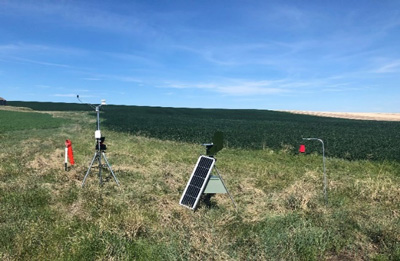
We run self-built rotorod spore samplers (right), solar-powered cyclone spore samplers (center), and passive windsock spore traps (far left) side-by-side in the field to compare if and how the spore samplers differ in capturing fungal wheat pathogens. Larger image (239KB).
Comparing Active and Passive Spore Samplers for Their Efficacy in Capturing Airborne Spores of Important Fungal Pathogens in the Montana Environment
Collaborators: Uta McKelvy (MSU). Graduate student: Karl Everet Owen.
In this project, we compare the performance of different spore samplers in capturing fungal wheat pathogens and assess their suitability for use in the Montana environment. The spore samplers in this study range from cost-effective, self-built models to high-value, manufactured types. We will also develop molecular tools for the identification and quantification of pathogen spores in our laboratory.
This project is funded by the MSU College of Agriculture Minigrant.
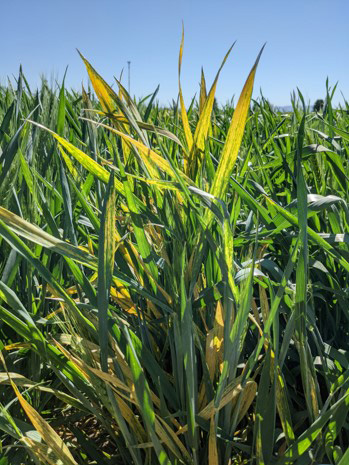
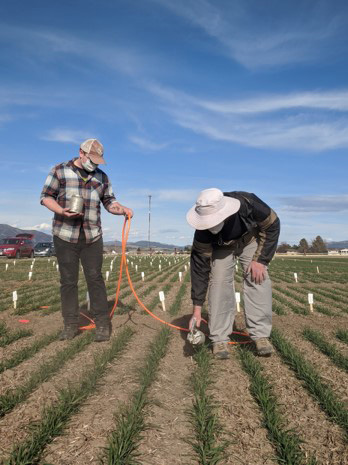
Developing New Wheat Germplasm With Disease and Mite Resistance
Collaborators: Mary Burrows, Phil Bruckner, Jason Cook, Uta McKelvy (MSU). Graduate student: Paul Lorenzo.
Wheat streak mosaic, caused by wheat streak mosaic virus (WSMV), is an important viral disease threatening winter wheat production in Montana and the Great Plains. Variety selection can play a critical role in reducing losses due to the virus. In this project we screen recently developed MSU breeding lines for susceptibility to WSMV and its virus vector, the wheat curl mite.
Left photo: Graduate student Paul Lorenzo (right) inoculates young winter wheat plants with wheat
streak mosaic virus using a pressure spray gun. Larger image (65 KB)
Right photo: Closeup of a wheat streak mosaic virus infected winter wheat plant, showing characteristic
symptoms of yellow striping and mosaic patterns on the leaves. Larger image (105 KB)
This project is funded by the Montana Wheat and Barley Committee.
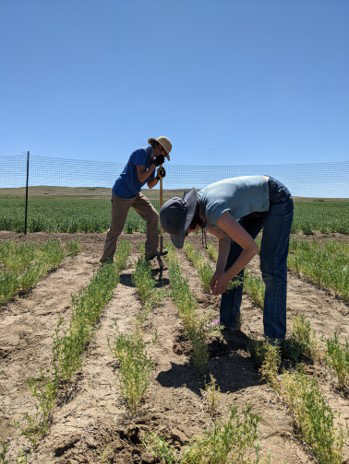
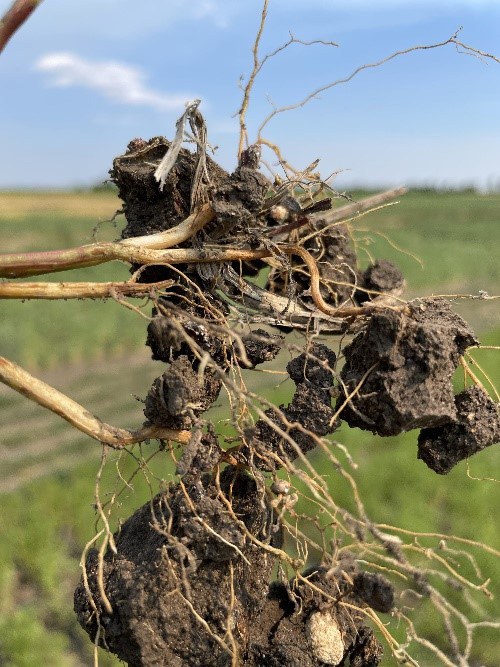
Building a Better Lentil From the Ground Up
Collaborators: Uta McKelvy, Mary Burrows, Perry Miller from MSU, along with Clarice Coyne, Michael Grusak, Rebecca McGee, and Lyndon Porter from the United States Department of Agriculture, Agricultural Research Service (USDA-ARS), Julie Pasche from North Dakota State University (NDSU). Graduate students at MSU: Collins Bugingo, Sydney Atencio.
Lentil is a uniquely suited and profitable rotational crop within the dryland wheat systems of the northern Great Plains and Pacific Northwest. However, root rot is a major threat to the lentil industry and there are few effective management options. One of the objectives of this project is to discover the major Fusarium spp. causing root rot in lentil, explore their interactions and the role of seed transmission in establishment and spread of the disease.
More information about this project can be found on the Building a Better Lentil website.
Left photo: Closeup of a lentil root showing brown discoloration from Fusarium root rot. Larger image (154 KB)
Right photo: Researchers dig up lentil plants to assess the roots for symptoms and severity of
root rot. Larger image (70 KB)
This project is funded by the United States Department of Agriculture, National Institute of Food and Agriculture Specialty Crop Research Initiative (USDA-NIFA).
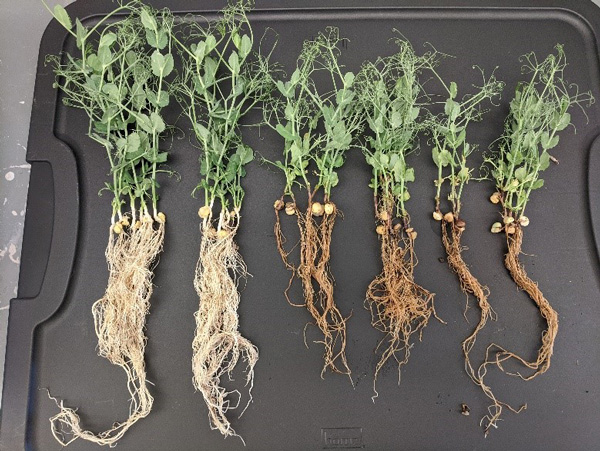
Comparison of healthy and diseased dry pea roots. Plants from the two control pots (left), show well-developed, white, healthy roots. Plants from the four pots with disease inoculum (right), have reduced root mass showing caramel-brown discoloration caused by Aphanomyces root rot. Image: Carmen Murphy. Larger image (152 KB).
Predicting Soilborne Disease Risk of Pulse Crops
Collaborators: Carmen Murphy, Monica Brelsford (MSU).
Soilborne diseases are a major limiting factor to the yield and quality of pulse crops worldwide. Many of the pathogens causing disease are difficult to manage due to long-lived spores, broad host ranges, and limited to no fungicide options. Complete and rapid crop failure due to root rot can occur given the right environmental conditions, with multiple pathogens often involved in a ‘complex’ of species (Aphanomyces euteiches, Fusarium spp., Pythium spp., Phytophthora spp., and Rhizoctonia solani). This project offers Montana growers free soil testing for soilborne pathogens to help determine their risk for pulse crop root rot. Samples are also tested for soil edaphic properties, to analyze potential correlations between soil properties and disease.
This project is funded by the Montana Specialty Crop Block Grant.
Further Information about MSU Extension Field Crop Pathology Research Projects
Contact Uta McKelvy for more information about the research projects at MSU Extension Field Crop Pathology and the McKelvy Lab.
For general plant disease inquiries and diagnosis, contact the Schutter Diagnostic Lab.
